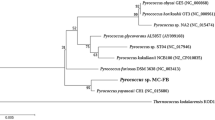Abstract.
We have cloned, sequenced, and overexpressed in Escherichia coli the amidase gene from the hyperthermophilic archaeon Sulfolobus solfataricus (strain MT4). The recombinant thermophilic protein was expressed as a fusion protein with an N-terminus six-histidine-residue affinity tag. The enzyme, the first characterized archaeal amidase, is a monomer of 55,784 daltons, enantioselective, and active on 2- to 6-carbon aliphatic amides and on many aromatic amides, over the pH range 4–9 and at temperatures from 60° to 95°C. The S. solfataricus amidase belongs to the class of amidases that share a characteristic signature, GGSS(S/G)GS, located in the central region of the protein, and which show remarkable variability in their individual substrate specificities, can hydrolyze aliphatic or aromatic substrates, and share a large invariance of their primary structure.
Similar content being viewed by others
Author information
Authors and Affiliations
Additional information
Electronic Publication
Rights and permissions
About this article
Cite this article
d' Abusco, A., Ammendola, S., Scandurra, R. et al. Molecular and biochemical characterization of the recombinant amidase from hyperthermophilic archaeon Sulfolobus solfataricus . Extremophiles 5, 183–192 (2001). https://doi.org/10.1007/s007920100190
Received:
Accepted:
Issue Date:
DOI: https://doi.org/10.1007/s007920100190



